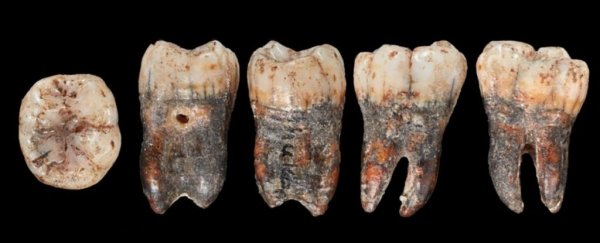In 1928, the renowned British archaeologist, Dorothy Garrod, excavated the Shukbah Cave in the hills of Palestine, just north of Jerusalem.
This was some of her earliest work in a long and successful career, revealing a rich collection of ancient stone tools, animal bones, and a single fossilised tooth - what looked like a large human molar.
For fifty years the discovery was lost in the private collection of a collaborator, unrecognised and neglected. Then, at the turn of the century, the long-lost tooth landed in the laps of researchers at the British Museum of Natural History.
Looking closely at the large molar, researchers realised it was probably from a young Neanderthal, possibly between the ages of 7 and 12.
To date, the Shukbah tooth is the southernmost example of the Neanderthal range in Arabia.
"Up to now we have no direct evidence of a Neanderthal presence in Africa," says Chris Stringer, who studies human evolution at the Natural History Museum.
"But the southerly location of Shukbah, only about 400 km from Cairo, should remind us that they may have even dispersed into Africa at times."
What's more, the associated stone tools excavated nearby looked remarkably modern in their illustrations.
When Garrod found the tooth all those years ago, she immediately suspected it was from a Neanderthal, but because her discovery became lost in a private collection, the claim was never verified.
Other associated artefacts she unearthed from the Shukbah cave, including flakes, points, and retouched tools, were also separated and dispersed to several global institutions over the years.
Re-analysing the tooth and these tools decades later, researchers at the British Museum have confirmed the molar did, in fact, belong to a Neanderthal child, roughly 9 years of age.
What's more, the stone tools excavated near this Neanderthal child appear to have been made using a method of stone knapping thought to have been exclusively used by Homo sapiens.
This type of knapping is known as the Nubian Levallois technique, and its presence in southern Arabia during the Palaeolithic is sometimes thought to mark the expansion of Homo sapiens out of Africa.
As such, several other excavations in the region have simply assumed the presence of Nubian Levallois tools were made by Homo sapiens, even without fossilised human remains nearby to support that hunch.
But there is another explanation. The area in which Garrod was excavating all those years ago has a relatively high concentration of cave sites with remnants of ancient hominin societies.
Over the years, discoveries in this important hub, many of which were made by Goddard, have revealed a landscape inhabited by both Neanderthals and Homo sapiens.
The Nubian Levallois technique might therefore have been adopted by Neanderthals moving from Europe further south, which meant the method may have been used by both Neanderthals and Homo sapiens at the same time.
The differences between Neanderthals and Homo sapiens have become harder to define in recent years, and this new research suggests using the presence of stone tools as a way to determine whether the site was connected to Neanderthals or Homo sapiens is insufficient on its own.
The stone tool technology found in the Shukbah caves shares broad characteristics with other mid-late Palaeolithic finds associated with Neanderthals. Yet the authors say the Nubian Levallois method was clearly there in some specimens.
"In the end, we identified many more artefacts produced using the Nubian Levallois methods than we had anticipated," says archaeologist Jimbob Blinkhorn, who worked on the research while at the University of London.
"This is the first time they've been found in direct association with Neanderthal fossils, which suggests we can't make a simple link between this technology and Homo sapiens."
The finding falls short of proof that Neanderthals crafted the tools themselves using this method. Stone implements could have been a valued commodity worth sharing. But it's enough to shake confidence that the technology can be used to distinguish a specific human presence.
The range of Neanderthals in southern Arabia is often restricted to the woodlands, but the Shuqbah cave might have represented a transition phase between these lusher areas and more arid landscapes in the south, the authors suggest.
"This study highlights the geographic range of Neanderthal populations and their behavioural flexibility," says archaeologist Simon Blockley from the University of London.
"But also issues a timely note of caution that there are no straightforward links between particular hominins and specific stone tool technologies."
The study was published in Scientific Reports.
